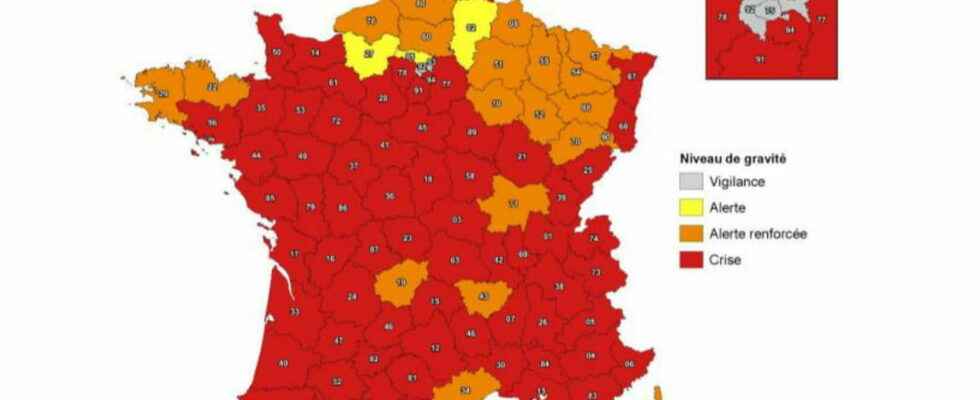DROUGHT. Almost all departments in France are affected by drought alerts. Water restrictions have been recorded in more than 90 departments while around sixty are in a “crisis” situation. We take stock.
[Mis à jour le 08 août 2022 à 16h34] Is France headed for a water shortage before the end of the summer, or even this fall in certain areas? The historic drought that France is experiencing in this summer of 2022 is already having many effects. While the water reserves are dry in a hundred rural municipalities, forcing the authorities to ration and supply by cisterns, numerous measures have been announced following a month of July 2022 considered to be the most dry since 1959. An interministerial crisis unit met on Friday August 5 around Prime Minister Elisabeth Borne. “The exceptional drought that we are currently experiencing is depriving many municipalities of water and is a tragedy for our farmers, our ecosystems and biodiversity”, underlines Matignon, who is worried that this drought, “the most serious ever recorded in our country. “, persists, even becomes “even more worrying”.
The whole country is concerned by one of the four levels of vigilance established by the State within the framework of the drought plan: “vigilance”, “alert”, “reinforced alert” and “crisis”. In total, 46 departments of France are concerned (in part or in full) by this last level of alert. Find all the practical information below or via our file in 20 questions and answers.
As of August 5, 2022, during the last survey, 93 departments in metropolitan France out of 96 are subject to water restrictions to varying degrees and 62, or two thirds of the country, are “in crisis”. In this highest level of alert, the watering of lawns, vehicles or the irrigation of crops are prohibited, as is the filling of bodies of water.
The departments at the “crisis” level (red alert): 62 departments are affected by this state of crisis for at least part of their territory. We can mention Bouches-du-Rhône, Drôme, Indre, Loire-Atlantique, Mayenne or Sarthe, but also on part of the territory Alpes-Maritimes, Dordogne, Ille et Vilaine, Isère , the Loiret, the Lot, the Puy-de-Dôme, part of the Var or the Vendée.
What is the drought map of France?
Propluvia is the institute of the Ministry of Ecological Transition responsible for monitoring water levels and the internet platform that allows direct consultation of water restriction orders. The site includes a scalable map to view the areas affected by these prefectural decrees.

The Ministry of Ecological Transition has also published a map summarizing the different alert levels.

Everywhere in France, water restrictions apply, at different levels. Concrete measures have been put in place to limit water consumption for individuals, businesses and communities. For example, it may be forbidden to wash your car or water your garden. In more than a hundred small towns in France, the pipes are empty, underlined the Minister of Ecological Transition Christophe Béchu. This is particularly the case in the Alpes de Haute-Provence. Le Fugeret, Le Castellet and Annot are all villages supplied with drinking water by trucks. A full list is expected the week of August 8, 2022.
There are four main levels of drought vigilance and all of them result in the implementation of specific measures.
- Vigilance drought (level 1): informing and encouraging individuals and professionals to save water.
- Alert (level 2): measures prohibiting the operation of valves, nautical activity, prohibition at certain times of watering gardens, green spaces, golf courses or washing one’s car. For farmers, reduction of levies for agricultural purposes below 50% (or ban up to 3 days a week).
- Heightened alert (level 3): stronger limitation of withdrawals for watering gardens, green spaces, golf courses, car washing, etc., until certain withdrawals are prohibited. For farmers, reduction of levies for agricultural purposes greater than or equal to 50% (or ban greater than or equal to 3.5 days per week).
- Crisis (level 4): cessation of non-priority withdrawals, including withdrawals for agricultural purposes. Only withdrawals to ensure the exercise of priority uses are authorized. They concern sectors such as health, civil security, drinking water and sanitation.
As drought episodes are more and more frequent in France, the Ministry for Ecological Transition and Territorial Cohesion and the Ministry for Energy Transition have published an informational video on their Twitter account on the causes and consequences of the drought, but also on the daily gestures to put in place, whether you are an individual, a company or a community, to reduce your water consumption.
Drought episodes are more and more frequent and begin earlier in the year.
What are the causes and consequences of these phenomena? How to act on a daily basis to reduce your water consumption? Answers in pictures @AdeMontchalin pic.twitter.com/3dJYhmn0xs
Individuals have a role to play in limiting drought, in particular through small daily gestures summarized by the website of the Ministry of Ecological Transition:
- Avoid letting the water run
- Limit the watering of my garden,
- Install water-saving equipment,
- Take a shower instead of a bath
- Install a rainwater collector or containers under the gutter downspouts and in the garden to water it,
- Repair water leaks,
- Avoid running your washing machine or dishwasher half empty.
